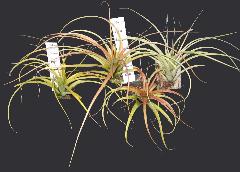
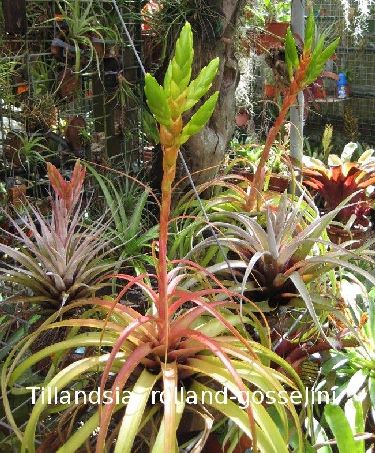
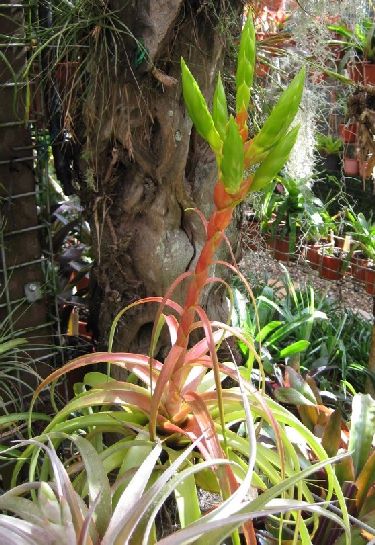
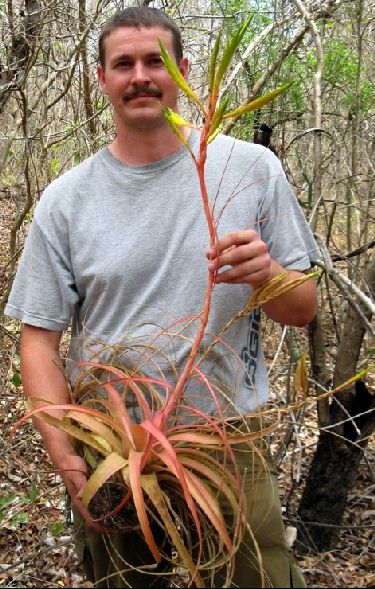
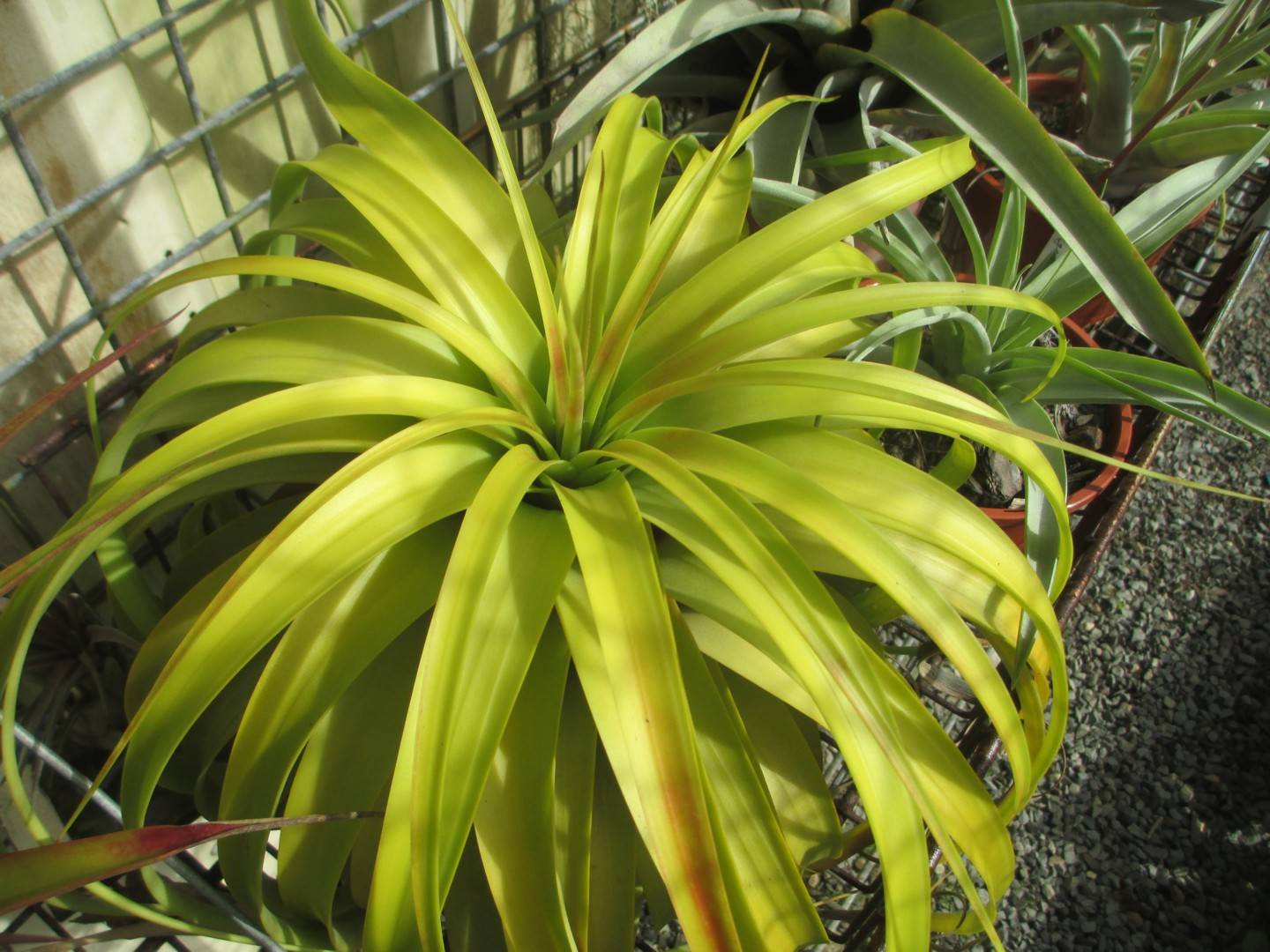
DISTRIBUTION. Known from the type collection only.
{DISTRIBUTION. Epiphytic in coastal woods, southern Mexico. MEXICO: Guerrero: near Acapulco, Feb 1895, E. Palmer 547 (GH, MO, US); between Acapulco and Pinotepan (Oaxaca), 30 Mar 1967, Matuda 38288 (MEXU, US).}
NOTE. In his original description Mez compares T. roland-gosselinii with T. parryi and T. uhdei, but in the key in the Pflanzenreich he places it far away from them on the basis of the primary bracts being longer than the spikes. Yet in both descriptions he says that they are shorter. With only the description to rely on I am distinguishing it as having denser floral bracts that wholly cover the rhachis.
Tillandsia roland-gosselinii Mez, Repert. Sp. Nov. 14: 249. 1916.
Desc from S&D
Plant stemless, large.
Leaves densely rosulate, 45 cm long, densely and minutely pale-appressed-lepidote throughout;
sheaths distinct, pale brown-lepidote toward the base;
blades long-attenuate, 4 cm wide at the base, the outer ones bright green, the inner reddish at anthesis.
Scape stout, slightly shorter than the leaves;
scape-bracts densely imbricate, reddish, produced into slender elongate recurved blades.
Inflorescence exceeding the leaves, pinnately compound with simple branches, dense, subfusiform, 25 cm long, 5 cm in diameter, glabrous, bright red;
primary bracts much shorter than the axillary spikes, the lower ones with foliaceous blades exceeding the spikes;
spikes strict, imbricate, long-stipitate with several imbricate sterile bracts at base, fusiform, 7 cm long, exclusive of the sterile base, 6-flowered, subterete especially toward the apex.
Floral bracts densely imbricate, acute, 35 mm long, much exceeding the sepals, sharply carinate, uncinate-incurved, coriaceous, even, glabrous, lustrous;
flowers erect.
Sepals (immature) broadly acute, 22 mm long, subcoriaceous, prominently nerved, equally subfree.
TYPE. Diguet in Roland-Gosselin Hortus s n (B? n v ), 400 in alt, Colima, Mexico.
DISTRIBUTION. Known from the type collection only.
NOTE. In his original description Mez compares T. roland-gosselinii with T. parryi and T. uhdei, but in the key in the Pflanzenreich he places it far away from them on the basis of the primary bracts being longer than the spikes. Yet in both descriptions he says that they are shorter. With only the description to rely on I am distinguishing it as having denser floral bracts that wholly cover the rhachis.
Tillandsia maritima Matuda, Cact. & Sucul. Mex. 16: 90, fig. 47. 1971.
Desc from S&D
Plant stemless, flowering 17-40 cm high.
Leaves many in a crateriforrn rosette, 25-42 cm long;
sheaths broadly ovate, 7 cm long, dark castaneous with fine, white scales;
blades recurving, narrowly triangular, caudate-attenuate, 12 mm wide at base, minutely pale lepidote throughout.
Scape erect, exceeding the leaves;
scape-bracts imbricate, with linear-subulate blades to 15 cm long, red-brown.
Inflorescence short-pinnate or digitate or rarely simple;
primary bracts like the upper scape-bracts, scarcely larger than the floral bracts;
spikes 1-8, erect to divergent, narrowly lanceolate, attenuate, 6-9 cm long including the slender, bracteate, sterile base, 15 mm wide, complanate densely 8-12-flowered.
Floral bracts lanceolate, acute, 25-30 cm long, exceeding the sepals, strongly carinate, thin, strongly nerved;
flowers subsessile.
Sepals lanceolate, the posterior carinate;
petals to 55 cm long;
stamens exserted.
TYPE. Matuda 38361 (holotype MEXU), epiphytic in high woods near the coast, Axamala, Jalisco, Mexico.
Distribution. Epiphytic in coastal woods, southern Mexico. MEXICO: Guerrero: near Acapulco, Feb 1895,E. Palmer 547 (GH, MO, US); between Acapulco and Pinotepan (Oaxaca), 30 Mar 1967, Matuda 38288 (MEXU, US).
Tillandsia maritima, Matuda sp. nov. Cact. & Sucul. Mex. 16: 90, fig. 47. 1971.
A Tillandsia fasciculata Swartz cui affinis, sed tota badio umbrinus vel rubescentia, spicis multo minoribus, folia multa dense fasciculata, lamina angosto linearia, canaliculata, longe-caudata, involuta, 40 cm longa, 1cm lata differt.
Plant acaulis, epiphytic, 35-40 cm high including the scape;
leaves 35-42 cm long disposed in a multi-rosette bowl;
sheaths long oval, 7 cm long, 3.5 cm wide, dark chestnut brown with fine white appressed scales;
blades 1.2 cm wide at the base, linear-acuminate-caudate-subulate, many longitudinal nerves, brilliant chestnut brown, finely white scaled on both faces;
Scape erect, ascending, thick, exceeding the leaves;
scape bracts imbricate, reddish-chestnut brown, linear-subulate, 13-15 cm long, reflexed;
Inflorescence digitate to bipinnate with 5-7 spikes;
Spikes erect to spreading, with 8-12 flowers, with sterile bracts at the base, 6-7 cm long, 1.5 cm wide;
Floral bracts 2.5-3.0 cm long, 1.0 cm wide, lanceolate, red, strongly carinate.
Flowers erect, subsessile;
Sepals carinate, lanceolate, 3 cm long;
Petals to 5.5 cm long;
Stamens protruding.
Mexico: Jalisco; in high matorral near the coast, Axamala;
Type: Matuda 38361 deposited in the National Herbarium, Institute of Biology of the Autonoma University of Mexico.
Also examined another collection by Carlos Beutelspacher, without number, coming 20 km from Pinotepa Nacional, Oaxaca, on April 23 1971.
This Tillandsia is found on the Pacific coast in the States of Jalisco, Colima, Guerrero and Oaxaca as well as Michoacan where it grows in the region of the Presa del Infiernillo. It grows in abundance epiphytically from 10 to 30 m high in the low deciduous forest. In the rainy season the leaves are a dark green colour but during the drought the leaves acquire a beautiful brilliant brown colour and the bracts a rosy color that really stand out. It is very strange that this species has not been described before, being so abundant on the Pacific coast.
Tillandsia roland-gosselinii by Sue Gardner in J. Brom. Soc. 32(2): 61-2. 1982
Tillandsia roland-gosselinii Mez was originally collected from near Colima in southwestern Mexico and described by Carl Mez in 1916. Since no type specimen has been located, only the description and locality of the collection was available to help determine what this species actually is. In the winter of 1980, we traveled through Colima and found that a species which we had known as T. maritima Matuda was a common inhabitant of the dry thickets which cover the rolling hills around the city. By comparing these plants with Mez's published description, we found that the agreement between them was remarkable. It appears, then, that the names T. roland-gosselinii and T. maritima refer to the same plant. It is distributed over many miles of the southwestern coast of Mexico, ranging from southern Jalisco through Guerrero but never occuring very far from the coast. This distribution pattern was the basis for Matuda's use of the word maritima for the specific name, which means "growing by the sea."
This species has also been known in the trade under the name 'Coronado', given to it by L. E. Guerra, a nurseryman and importer of Mexican plants in Mission, Texas. Since he did not know the name of the plant when he originally received it, and he needed a name in order to be able to sell it, 'Coronado' was chosen to describe the colorful foliage.
Whether you choose to call this species by the colorful name 'Coronado', or by its proper name T. roland-gosselinii, it is a rewarding species to grow. It offers much color and grace and demands little care and attention. Unfortunately, it does not reproduce rapidly since it typically produces one offset from near the center, replacing itself, but not providing any increase in the number of rosettes.
Tillandsia roland-gosselinii Mez, Repert. Sp. Nov. 14: 249. 1916.
Tillandsia maritima Matuda, Cact. Suc. Mex. 16: 90. fig. 47. 1971 (according to Gardner, 1982,1986b).
By McVaugh in Flora Novo Galiciana 1989
Presumably on trees in deciduous forest, lowlands and foothills of the Pacific slope, from near sea-level to 500 m or more, probably flowering in fall and winter. Jai. (Axamala, Matuda 38361, MEXU, holotype of T. maritima), Col. (Colima, 400 m, Diguet, the type from a plant cultivated by Roland-Gosselin, the holotype not seen by Smith nor by Gardner but ascribed with question to Berlin {B}); also, according to Gardner (1982) in Mich. east of our limits, and in Gro.
Near the city of Colima (Gardner 1366!, cited by Gardner, 1982); {probably near Colima, on the road from Manzanillo} (Gardner 1365!).
Plant acaulescent, large;
leaves in a dense rosette, 45 cm long, densely pale lepidote, rigidly recurved;
sheaths distinct, pale brown-lepidote toward base;
blades long-attenuate, 4 cm wide at base, the inner ones reddish at anthesis;
scape stout, slightly shorter than the leaves, its bracts closely imbricated, reddish, produced into slender elongate recurved blades;
inflorescence pinnately compound with simple branches, 25 cm long, 5 cm in diameter, dense, subfusiform, glabrous, bright red;
primary bracts (sheaths) much shorter than the axillary spikes, "crimson" (G), the lower ones with long foliaceous blades exceeding the spikes;
spikes erect, stipitate with sterile bracts at base, 7 cm long exclusive of the sterile base, fusiform, subterete especially toward apex, 6-flowered;
floral bracts densely imbricated, acute, 35 mm long, much exceeding the sepals, sharply keeled, uncinate incurved, coriaceous, even, glabrous, lustrous, "crimson and citron" (G),
flowers erect;
immmature sepals broadly acute, 22 mm long, subcoriaceous, nerved, all, essentially free;
corolla, androecium, and firuit not seen.
.
The plant described above way well be the true Tillandsia roland-gosselinii, and it is certainly the plant so called by Gardner. The description is adapted from that by Smith (1938, and in Smith & Downs, 1977), with notes on color from Gardner's publications. In her discussion of reproductive biology (1982, p. 85) Gardner described the living plant: “This species has red scape and primary bracts, and slick, green floral bracts. As the inflorescence develops the entire rosette of leaves also becomes scarlet. With this color combination, lavender diurnal flowers would be expected. The flowers were, instead, pale chartreuse, and anthesis was typically predawn." (See also Gardner's discussion, with an illustration in color, in J. Bromel. Soc. 32: 61-62. 1982.)
Whether or not this is the true T. roland-gosselinii, its taxonomic status should be further investigated. It seems no more than dubiously distinct from a plant that is common near the coast of Jalisco and Colima; that is, the one referred by Magana (1986), and in this Flora, to T. fasciculata. The two are strikingly similar in habit, about the same size, each with a rosette of rigidly recurved leaves surmounted by a pedunculate, pinnately few-branched inflorescence. The spikes, and the size, shape, and arrangement of the floral bracts, are similar in the two plants. Flower-color is similar (pale chartreuse in T. roland-gosselinii, greenish white in T. fasciculata). The major difference between the two is apparently in the floral bracts, which are strongly nerved in the population from the coastal lowlands, but much less so in specimens from near Colima. In Gardner's dried specimens of T. roland-gosselinii the bracts are smooth, or in some inflorescences nerved but not strongly so. It may be that the nerves are evident in the dried specimens only.
In this connection the status of Tillandsia maritima Matuda should be examined further. I have not seen the holotype, but it was studied both by Gardner, who assigned it without comment to the synonymy of T. roland-gosselinii, and by Magana, who believed T. maritima to be a synonym of T. fasciculata. Matuda himself (who did not mention in the protologue the nervation or lack of it in the floral bracts) contrasted T. maritima with T. fasciculata. Smith (in Smith & Downs, 1977) recognized T. maritima as a distinct species, with "floral bracts strongly nerved," contrasting it with T. roland-gosselinii, with floral bracts {as described in the protologue} "even, glabrous, lustrous." He referred to T. maritima two collections from lowland Guerrero that Gardner (1982) subsequently cited as T. roland-gosselinii.
I find no locality in Jalisco called Axamala. I suspect that Matuda meant either Chamela, now well known as the site of a biological station, or, as suggested to me by Biol. Magana, Cuitzmala, also near the coast of Jalisco, about 5 km east of Punta Farallon.